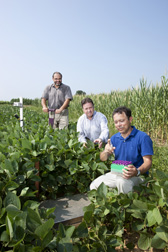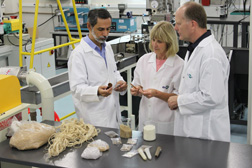“Labs Without Borders” Fosters New Opportunities
Thanks to the international exchange program LABEX-USA, Agricultural Research Service scientists in the Bioproduct Chemistry and Engineering Research Unit in Albany, California, have enjoyed a close working relationship with visiting Brazilian researchers. Since 2005, the partnership has given rise to around 25 published papers on advances in nanotechnology and biomaterials science, 2 patents, and new microfiber-spinning procedures for creating nonwoven polymer sheets with potential medical applications.
Launched in April 1998, LABEX is a trust-fund cooperative agreement between ARS and the Brazilian Agricultural Research Corporation (EMBRAPA), an agency of Brazil’s Ministry of Agriculture, Livestock, and Food Supply, headquartered in Brasilia. The “virtual laboratory” program, as LABEX is also known, operates on the principle that agricultural issues of mutual interest to the United States and Brazil are best addressed by bringing multiple points of view to bear on a research question or problem, facilitating an open exchange of scientific expertise, and pooling available resources. In the process, the limitations of any single research organization or facility become less of an impediment to success.
As two of nine EMBRAPA researchers who’ve worked at Albany, for example, Luiz Mattoso and Eliton Medeiros played a key role in the success of the microfiber-spinning project. They coauthored a May 2009 Journal of Applied Polymer Science paper on the advance with Bill Orts, the ARS lab’s research leader; Greg Glenn, a plant physiologist; and Artur Klamczynski, a food technologist.
“LABEX takes the traditional parameters off so we can figure out how best to solve problems. It goes beyond conducting parallel research programs; it’s more conjoined,” explains Eileen Herrera, deputy director of ARS’s Office of International Research Programs (OIRP), in Beltsville, Maryland.
According to Ladislau Martin Neto, the LABEX program coordinator there, ARS has hosted 20 senior scientists from EMBRAPA since 1998 at multiple locations across the country, where they’ve been involved in diverse projects generally lasting 2 to 3 years. Recent examples include Cesar Miranda’s studies determining total energy of perennial and tropical grasses at the ARS Grain, Forage, and Bioenergy Research Unit in Lincoln, Nebraska; Janice Ciacci-Zanella’s contribution to research on H1N1 swine influenza and porcine reproductive and respiratory syndrome viruses at the ARS National Animal Disease Center in Ames, Iowa; Alfredo Alves’s work on germplasm preservation of vegetative material using wild cassava as a model plant at the ARS National Center for Genetic Resources Preservation in Fort Collins, Colorado; Magda Benavides’s research on unraveling host genetic resistance to gastrointestinal parasite infections at the ARS Bovine Functional Genomics Laboratory in Beltsville, Maryland; and Martin Neto’s research on climate change mitigation and soil carbon sequestration at the ARS Sustainable Agricultural Systems Laboratory in Beltsville.
A Two-Way Street
Now, OIRP is encouraging ARS researchers to consider doing the same—that is, to travel to any one of EMBRAPA’s 46 research centers (some of which are uniquely focused on specific crops or environmental conditions) to work on projects of mutual interest to the United States and Brazil for tours of duty well beyond the standard 1- to 2-week stints.
Indeed, Glenn, Orts, and ARS botanist De Wood are finalizing plans for 1- to 15-month-long assignments at EMBRAPA’s Agricultural Instrumentation Center in São Carlos and other sites. “Greg’s joint project with Luiz Mattoso will involve creating novel nano-composites, biomaterials, and rubber-based biomaterials. De will learn new analytical techniques,” says Orts. While the Albany lab undergoes a planned renovation this year, Orts will travel to São Carlos to help organize an upcoming ARS-EMBRAPA workshop, cowrite new proposals to expand LABEX-USA, and finish several papers for publication with Brazilian coauthors.
World Centric, a Palo Alto, California, firm specializing in biodegradable single-use packaging, cups, utensils, and other items, is helping support Glenn’s trip as part of an existing cooperative research and development agreement with the ARS lab.
Science Overseas
The Albany group is on the forefront of a broad realization by ARS scientists of the merits of conducting studies abroad for extended periods—excluding the multi-year tours required of those assigned to ARS’s four main overseas biological control labs. These labs, which include a staff of foreign-service nationals, are in Montpellier, France; Beijing, China; Brisbane, Australia; and Buenos Aires, Argentina. ARS also has a screwworm facility in Panama City, Panama.
“The United States for many years has been the center of gravity for research,” says Herrera. “That center of gravity has flattened out, and now researchers perceive they can get a lot of productivity from working overseas.”
Ryan Moore, an OIRP international affairs specialist who works with Martin Neto on the LABEX program, agrees: “Traditionally, foreign scientists have come to the U.S. to conduct long-term research, not the reverse. But that attitude is changing among U.S. researchers.”
Countering the threat posed by invasive species is one area where hopping a flight to Brazil or other countries for collaborative research could be especially fruitful. “Under a labs-without-borders program, scientists can go to places where problem organisms are endemic and do more effective research on them,” says Herrera.
Collaborating with a host country’s scientists increases the likelihood of success because of the expertise and familiarity they often possess on the target organism, its natural habitat, or its natural enemies. An example is joint research conducted by ARS scientists in Kerrville, Texas, and EMBRAPA in Campo Grande, Brazil, to develop novel vaccines against Rhipicephalus (Boophilus) microplus ticks. The team’s members are Renato Andreotti of EMBRAPA and Felix Guerrero and Adalberto Pérez de León of ARS.
Other projects that could put ARS scientists on flights to Brazil—or to other locations where EMBRAPA also has overlapping research responsibilities—include research on animal waste management, citrus greening, orange rust of sugarcane, biological nitrogen fixation, bioenergy, animal genomics and health, water-resource management, and climate change research. All are pressing issues of relevance to the continued sustainability and productivity of not only America’s agricultural system and economy, but also that of its partners.
“ARS’s decision to expand and strengthen our cooperation by sending their researchers to Brazil will have a relevant impact towards obtaining new achievements of mutual interest,” says Martin Neto, who is on a 2-year appointment at OIRP from EMBRAPA.
“Virtualization of the research is becoming easier to consider,” adds Herrera. “It’s an excellent opportunity for us, the United States, to really enhance our science.”
ARS researchers interested in collaborating with EMBRAPA scientists abroad should contact Martin Neto or Moore at OIRP, using the contact information below.—By Jan Suszkiw, Agricultural Research Service Information Staff.
Eileen Herrera, Ryan Moore, and Ladislau Martin Neto are with the USDA-ARS Office of International Research Programs, 5601 Sunnyside Ave., Beltsville, MD 20705-5141; (301) 504-4521 [Herrera], (301) 504-4535 [Moore], (301) 504-4556 [Martin-Neto].
"“Labs Without Borders” Fosters New Opportunities" was published in the October 2011 issue of Agricultural Research magazine.








